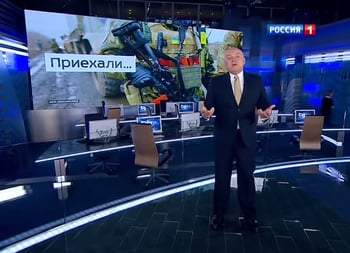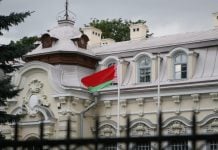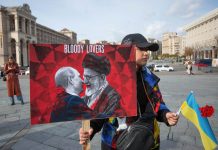Long after Boris Nemtsov’s killers are caught and Putin is gone, we’ll still be dealing with the legacy of the current media climate.
As Russia watcher Mark Galeotti has written, we don’t know who murdered Boris Nemtsov, but we can’t ignore that his killing took place in an “increasingly toxic political climate that clearly is a product of Kremlin agency, in which people like Nemtsov are portrayed as Russophobic minions of the West, enemies of Russia’s people, culture, values, and interests.”
Long before the gunmen pulled up in their little white car near the Kremlin, it was time to worry about the stew of paranoia and violent rhetoric that Russia’s official message-makers had been cooking up and ladling out via the country’s airwaves.

The most basic ingredient has been the idea that the West does not want a strong Russia and that those who speak out against the regime of Vladimir Putin really seek to prevent the country from taking its rightful place as a superpower – whether they be hawks in the U.S. State Department or their lackeys in the creative classes of Moscow and St. Petersburg.
Added later was the idea that Putin is fighting to preserve Russia’s traditional cultural values against a tide of European degeneracy that threatens to spill over its borders.
But most recently, in the past year, has come the notion that Russia is on the side of the righteous victim facing a neo-Nazi onslaught in the Ukraine conflict. Given the West’s support of the government in Kyiv, this sits easily alongside the nefarious-West narrative that has been a cornerstone of the Putin years.
In modern Europe, this type of propaganda tends to cease because of some rupture – a popular uprising ousts a government, war breaks out, a dictator dies. But the effects of the propaganda linger much longer, as has been the case in Serbia.
While the different circumstances are significant – among them, Serbia was overtly at war, while the Kremlin insists that Russia is not, and a nationalist leader who mattered at the time, Vojislav Seselj, was calling for a population exchange of Serbia’s Croats for Croatia’s Serbs – so are the similarities.
Like Slobodan Milosevic, Putin understood early the importance of getting a grip on television, though their ways of doing so necessarily differed. Unlike Putin, Milosevic did not have to elbow aside oligarchs in what was already a state-controlled media environment, and he imprisoned some journalists and levied hefty fines on others.
The imprisonment of journalists under Putin has been rare, but their assaults and murders have not been. State-controlled media have installed editors friendly to the Kremlin, foreign (read: independent) media owners are being pushed out, and a broad anti-extremism law opens the door to more aggressive policing of content (and has shut down some outlets’ comments sections).
Some of the tactics and the rhetoric of the countries’ leaders and their lapdog media have been eerily similar. Milosevic sought to create “a state for all Serbs,” while Putin has spoken of Novorossiya and the duty to protect Russians, wherever they may live. State media have driven a wedge between peoples who had lived peaceably enough together – most Russians and what is essentially Ukraine’s pro-West majority. And state media in both cases used gross distortions or flat-out lies to sicken, shock, or frighten the domestic population: consider the discredited report by Russia’s Channel One in July that a 3-year-old boy had been crucified by the Ukrainian army in Slavyansk.
That incident carried echoes of an infamous fabrication by a Serbian journalist working for Reuters in 1991 who reported that 41 young Serb schoolchildren had been slaughtered by retreating Croatian soldiers in a Croatian village on the border with Serbia.
“Belgrade Television would devote hours of viewing time to the unconfirmed news,” wrote Renaud de la Brosse, an expert on hate media and propaganda, in a 2003 report for prosecutors at the Balkans war crimes tribunal in The Hague.
Although the Yugoslav army and Reuters denied the report the next day, it had the effect of reinforcing “the image nurtured by the Serbian media of a ‘criminal and genocidal’ Croatian people, just as it would undermine those who opposed the war and lead to a flood of fresh volunteers departing for the front,” de la Brosse wrote.
For those wondering how most Russians could be persuaded of such outlandish notions that a formerly kindred people, Ukrainians, are in thrall to fascist war criminals, Peter Pomerantsev recently described the step-by-step process of Russian state propaganda: offer slick, populist entertainment, break down critical thinking, poke at old national traumas, stoke resentments, and, finally, offer the possibility of greatness or “uplift,” as Pomerantsev calls it, through the heroism of their leaders.
The result is an extremely receptive audience and a worrying situation not only because it feeds the current war fever and endangers dissidents like Nemtsov, but also because it’s difficult to see how Russia itself will recover when and if this media regime is ever dismantled.
Turning again to Serbia, in a poll conducted more than a decade after the shooting had stopped in the former Yugoslavia, a plurality of respondents – 40 percent – believed that the war crimes tribunal was set up to fix blame on Serbs for wartime suffering. By the same percent, again a plurality, respondents believed Serbia should not cooperate with the court, and 71 percent believed convictions of Serbs had been on the basis of unfair trials.
So how do you take a people who, as Andreas Umland, an expert on Ukrainian and Russian history in Kyiv, observed recently “have now, in their majority, a deeply conspirological and Manichean view of Russian-Western relations, if not of the outside world in general” and help them climb down off that ledge?
Pomerantsev suggests investing in gritty reality show programming that addresses controversial issues, such as the prejudices inflamed by state media; or that examines people’s personal connections to historical events; or even helps to encourage critical thinking. He acknowledges, however, that distribution to Russian speakers outside Russia would be much easier than getting these shows an airing domestically.
Umland, too, calls for the West “to invest heavily in various information strategies, technologies, projects, and media to gradually overcome this situation, e.g., by way of first changing the dominant discourse of the Russian diasporas outside Russia.”
But even if Putin were replaced by a democratically minded figure tomorrow and we could start beaming these programs into Russia, they would likely face fierce psychological resistance. Surely many Russians have too much bound up in this good-versus-evil worldview, their own sense of victimhood, and the idea of fighting for a righteous cause to allow them to rethink their own political/emotional journey of the pastyear or five.
Some thinking on post-conflict societies posits that for reconciliation, as opposed to just an end to fighting, to take place, the combatants must be willing to change their attitudes toward each other, which in turn requires them to revisit their ideas of themselves. In the case of Russia and Ukraine, that gives us reason for pessimism and optimism. Pessimism because people need breathing space and encouragement for that kind of work, something the Kremlin’s media are not providing. Optimism because reconciliation is easier when the changes required are really a reversion to something people believed in the first place – in this case, that Ukrainians and Russians are brotherly nations.
That idea could still be recovered one day, although it becomes more remote with every new death in eastern Ukraine.
By Barbara Frye, TOL





